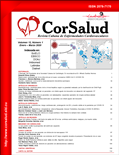Coronary artery fistula to the right ventricle in a patient with systemic atherosclerosis
Abstract
Atherosclerosis is a systemic disease that affects a number of vascular beds. Clinical manifestations whether acute or chronic (acute myocardial infarction, stable angina, intermittent claudication, cerebrovascular disease, among others) start after long periods of progression; so it may present subclinically in patients with coronary artery disease. What is particularly interesting about this form of presentation is that within a series of cases with multivessel disease, associated with an ankle-brachial index (ABI)<0.9, after an acute coronary syndrome, we have identified, as an angiographic finding, the presence of a coronary artery fistula to the right ventricle in a patient with very low ABI and clinical intermittent claudication. This fistula led to the symptoms that hampered cardiovascular rehabilitation. It is an infrequent disease characterized by chest pain; with low reporting (0.3 to 0.8%), as an incidental finding in coronary angiographies.Downloads
References
1. Mukherjee D, Eagle K. The importance of early diagnosis and treatment in peripheral arterial disease: insights from the PARTNERS and REACH registries. Curr Vasc Pharmacol. 2010;8(3):293-300.
2. Agnelli G, Cimminiello C, Meneghetti G, Urbinati S; Polyvascular Atherothrombosis Observational Survey (PATHOS) Investigators. Low ankle-brachial index predicts an adverse 1-year outcome after acute coronary and cerebrovascular events. J Thromb Haemost. 2006;4(12):2599-606.
3. Aboyans V, Ricco JB, Bartelink ME, Bjorck M, Brodmann M, Cohnert T, et al. Guía ESC 2017 sobre el diagnóstico y tratamiento de la enfermedad arterial periférica, desarrollada en colaboración con la European Society for Vascular Surgery (ESVS). Rev Esp Cardiol [Internet]. 2018 [citado 22 Ago 2019];71(2):111.e1-e69. Disponible en: https://doi.org/10.1016/j.recesp.2017.12.015
4. Alves-Cabratosa L, Garcia-Gil M, Comas-Cufí M, Blanch J, Ponjoan A, Martí-Lluch R, et al. Role of low ankle-brachial index in cardiovascular and mortality risk compared with major risk conditions. J Clin Med [Internet]. 2019 [citado 22 Ago 2019];8(6):870. Disponible en: https://doi.org/10.3390/jcm8060870
5. Badheka AO, Rathod AD, Bharadwaj AS, Bhat S, Kizilbash MA, Veeranna V, et al. Outcomes and risk prediction model for peripheral arterial disease in patients with stable coronary artery disease. Angiology. 2011;62(6):473-9.
6. Arroyo-Rodríguez C, Brito-Zurita OR, Sandoval-Navarrete S, Solis-Vásquez R, Ornelas-Aguirre JM, Olea-Hernández C, et al. Risk factors for three-vessel coronary artery disease in patients of Northwest México. Arch Cardiol Mex. 2018;88(5):423-31.
7. Saleh A, Makhamreh H, Qoussoos T, Alawwa I, Alsmady M, Salah ZA, et al. Prevalence of previously unrecognized peripheral arterial disease in patients undergoing coronary angiography. Medicine (Baltimore) [Internet]. 2018 [citado [citado 29 Ago 2019];97(29):e11519. Disponible en: http://dx.doi.org/10.1097/MD.0000000000011519
8. Basyouni MW, Shabana AM, El Kilani WM. Prevalence of lower extremities peripheral arterial disease among Egyptian ischemic patients attending cardiac rehabilitation unit. Egypt Heart J. 2018;70(4):295-299.
9. Cordero A, Morillas P, Bertomeu-González V, Quiles J, Soria F, Guindo J, et al. Pathological ankle-brachial index is equivalent of advanced age in acute coronary syndromes. Eur J Clin Invest. 2011;41(12):1268-74.
10. Davidson CJ, Bonow RO. Cateterismo cardiaco. En: Mann DL, Zipes DP, Libby P, Bonow RO, eds. Braunwald Tratado de Cardiología: Texto de Medicina Cardiovascular. 10ma ed. Filadelfia: Elsevier Saunders; 2015. p. 442-72.
11. Abdelmoneim SS, Mookadam F, Moustafa SE, Holmes DR. Coronary artery fistula with anomalous coronary artery origin: a case report. J Am Soc Echocardiogr [Internet]. 2007 [citado 31 Ago 2019];20(3):333.e1-4. Disponible en: http://dx.doi.org/10.1016/j.echo.2006.09.012
12. Branco VGC, Ramos LM, Coelho LCA, Amorim RO, Borges RM. Semiologia do aparelho cardiovascular. Anatomia e fisiologia. Rev Cad Med [Internet]. 2018 [citado 1 Sep 2019];1(1):55-65. Disponible en: http://www.revista.unifeso.edu.br/index.php/cadernosdemedicinaunifeso/article/view/753/438
13. Gascueña Rubia R, Hernández Hernández F, Tascón Pérez JC, Albarrán González-Trevilla A, Lázaro Salvador M, Hernández Simón P. Isquemia miocárdica demostrada secundaria a fístulas coronarias múltiples con drenaje en el ventrículo izquierdo. Rev Esp Cardiol. 2000;53(5):748-51.
14. Vicario J, Licheri A, Gerardo L, Lofeudo C. Sinusoides y fístulas coronarias a cavidad ventricular izquierda. Presentación de un caso clínico. Rev Fed Arg Cardiol. 2004;33(2):236-9.
15. Duran A, Michelis V, Díaz P, Lujambio M, Kuster F, Lluberas R, et al. Evaluación de pacientes portadores de fístulas coronario-ventriculares múltiples. Rev Méd Urug. 2003;19(3):237-41.
16. Urmeneta Ulloa J, Molina Borao I, Ochoa Rea ME, Sánchez-Insa E. Embolización percutánea en fístula de arteria coronaria previo al trasplante pulmonar. Arch Bronconeumol. 2017;53(9):520-1.
17. Jama A, Barsoum M, Bjarnason H, Holmes DR, Rihal CS. Percutaneous closure of congenital coronary artery fistulae: Results and angiographic follow-up. JACC Cardiovasc Interv. 2011;4(7):814-21.
18. Díaz de la Llera LS, Fournier Andray JA, Gómez Moreno S, Mayol Deya A, González García A, Pérez Fernández-Cortacero JA. Fístulas de arterias coronarias en adultos. Oclusión percutánea mediante coils. Rev Esp Cardiol. 2005;58(1):93-6.
Downloads
Published
How to Cite
Issue
Section
License
Authors who publish with this journal agree to the following terms:- Authors retain copyright and grant the journal right of first publication with the work simultaneously licensed under a Creative Commons Attribution License that allows others to share the work with an acknowledgement of the work's authorship and initial publication in this journal.
- Authors are able to enter into separate, additional contractual arrangements for the non-exclusive distribution of the journal's published version of the work (e.g., post it to an institutional repository or publish it in a book), with an acknowledgement of its initial publication in this journal.










